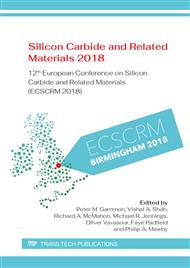[1]
T. Kimoto and J. A. Cooper, Fundamentals of Silicon Carbide Technology: Growth, Characterization, Devices, and Applications, first ed., Wiley-IEEE press, Singapore, (2014).
Google Scholar
[2]
S. Bellone et al., High-Voltage Bipolar Mode NET With Normally Off Characteristics, IEEE Elect. Dev. Lett, 6, 522-524 (1985).
DOI: 10.1109/edl.1985.26216
Google Scholar
[3]
G. Schweeger et al., Design and characteristics of a GaAs BMFET, Micr.Eng.,15 (1991) 13-316.
Google Scholar
[4]
S. Bellone et al., Design and performances of 4H-SiC bipolar mode field effect transistor (BMFETs), IEEE Trans. on Power Electronics, 29 (2014) 2174-2179.
DOI: 10.1109/tpel.2013.2281781
Google Scholar
[5]
S. Bellone et al, A model of the off-behaviour of 4H-SiC power JFETs, Solid State Electronics, 109 (2015) 17-24.
DOI: 10.1016/j.sse.2015.03.004
Google Scholar
[6]
Y. Li et al., 1.88-mΩ⋅cm21650-V Normally on 4H-SiC TI-VJFET, IEEE Trans. Elect. Dev., 55 (2008) 1880-1886.
Google Scholar
[7]
R. Nipoti et al,Al+ implanted anode for 4H-SiC p-i-n diodes, El.Ch.Soc.Trans.,50(2012)391-397.
DOI: 10.1149/05003.0391ecst
Google Scholar
[8]
S. Bellone et al, A quasi-one-dimensional model of the potential barrier and carrier density in the channel of Si and 4H-SiC BSITs, IEEE Trans. on Electron Devices, 59 (2012) 2546-2549.
DOI: 10.1109/ted.2012.2203601
Google Scholar
[9]
L. Di Benettto et al., Analytical Model and Design of 4H-SiC Planar and Trenched JBS Diodes, IEEE Trans. on Electron Devices, 63 (2016) 2474-2481.
DOI: 10.1109/ted.2016.2549599
Google Scholar
[10]
S. Bellone et al., A model of the ID-VGS characteristics of normally off 4H-SiC bipolar JFETs, IEEE Trans. on Power Electronics, 29 (2014) 514−521.
DOI: 10.1109/tpel.2013.2253336
Google Scholar
[11]
H. Miyake et al., Improvement of current gain in 4H-SiC BJTs by surface passivation with deposited oxides nitrided in N2O or NO, IEEE Elect. Dev. Lett. 32 (2011) 285-287.
DOI: 10.1109/led.2010.2101575
Google Scholar
[12]
G. D. Licciardo et al., Modeling of the SiO2/SiC Interface-Trapped Charge as a Function of the Surface Potential in 4H-SiC Vertical-DMOSFET, IEEE Trans. on Elect. Dev., 63 (2016)1783-1787.
DOI: 10.1109/ted.2016.2531796
Google Scholar
[13]
H. Rong et al., Combined N2O and phosphorus passivation for the 4H-SiC/SiO2 interface with oxide grown at 1400°C, Mat. Sc. Forum, 897 (2017) 344-347.
DOI: 10.4028/www.scientific.net/msf.897.344
Google Scholar
[14]
S. Bellone et al., A self-consistent model of the static and switching behaviour of 4H-SiC diodes," Proceeding of CAS, (2010) 405-408.
DOI: 10.1109/smicnd.2010.5650594
Google Scholar
[15]
B. J. Baliga, Silicon Carbide Power Devices, World Scientific, Singapore (2005).
Google Scholar
[16]
L. Di Benedetto et al., Optimized Design for 4H-SiC Power DMOSFET, IEEE Elect. Dev. Lett., 37 (2016) 1454-1457.
DOI: 10.1109/led.2016.2613821
Google Scholar


